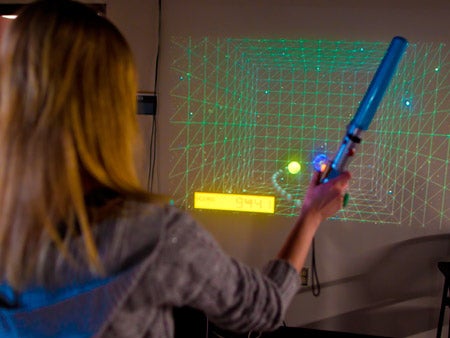Her movements animate an avatar— a cartoon-like student — sitting in a virtual classroom on the screen. Tapping a key, the puppeteer becomes the persona of one disruptive student, then another.
One simulator at UCF’s Institute for Simulation & Training can give off smells such as burning flesh or vomit. “We want to extinguish the disgust before they have to do it for real,” says Randall Shumaker, director of operations.
Hundreds of miles away, a teacher-in-training sits before another computer screen. From her end, she sees not the puppeteer, but rather only the misbehaving students. Her job: Keep them on task, as a professor at the prospective teacher’s school monitors the training.
This new virtual approach to preparing teachers for real-life classroom challenges — now being used at 10 teaching colleges — is just one experiment under way at the UCF institute.
The three-building complex located in UCF’s innovation/research park conducts experiments including military simulations, a visually accurate virtual walk-through of the 1964 World’s Fair, and a driver training simulator for long-haul truckers. One exercise tests how much distraction the driver of an 18-wheeler can handle — construction on the road, a ringing cell phone, music blaring through an iPod.
The projects are commissioned by universities, private companies, government departments and the military.
Using sophisticated software and real- life controls, humans are placed, virtually, into scenarios meant to gauge reactions, teach teamwork or train for specific results.
“Some of the simulation has multiple applications,” says Randall Shumaker, the institute’s director. Emergency personnel, for example, use driving simulators designed to train truckers.
Initially, the institute conducted most of its simulation for various branches of the U.S. Department of Defense — the Marines, Army and Coast Guard, which also have a presence in the research park and in the institute’s buildings. But in recent years, other uses for modeling and simulation have increased. Shumaker believes healthcare, education and medical simulation represent the most promising areas.
One carpeted room houses a tiny model city that resembles a town in Iraq, complete with mosques and a street bazaar. In a simulation where virtual or computer-generated elements are combined with real surroundings that are scaled down, truck drivers using remote control can collaborate with other vehicle operators and get the feel of navigating in an environment — with far fewer consequences.
Simulation experiments include a range of professionals, from psychologists to engineers, digital historians and anthropologists. Lori Walters, a historian, pulls out a blueprint mapping out what is becoming a precise, virtual re-creation of the 1964 New York World’s Fair. She describes how with a $1.4-million grant from the National Science Foundation, the institute is developing 3-D pavilions that resemble those at the real fair. The project is geared to 9 to 13 year olds who will be able to navigate the fair’s 648 acres and 140 pavilions with the click of a mouse. “We want them to take what they learn at one pavilion and apply it somewhere else at the fair,” Walters says. The project is scheduled to be finished next year.
“Even during the recession, the Department of Defense’s buying power has not wavered,” says retired Air Force Lt. Gen. Thomas L. Baptiste, president of the National Center for Simulation at the UCF institute.
Meanwhile, a few dozen feet away, a computer screen displays a virtual hospital room where nurses are able to interact with a computerized patient and get trained in pain management.
Programs developed in partnership with the U.S. Army are helping to train crisis managers, emergency medical technicians, fire rescue personnel and hospital medical staff. Trainees play a video game that simulates a combat area or trauma scene. Accompanying the game are life-like models of body parts that simulate a pulse, blood and underlying anatomy. An additional simulator can give off smells such as burning flesh or vomit. An obvious advantage of modeling is that the medical team can review what it did wrong and try again.
The National Center for Simulation — which shares space with the institute — helps to bridge the research between the public and private sectors. The trade group provides opportunities for about 162 member companies to network and tap into the $5 billion that the Department of Defense has budgeted for modeling and simulation products and services.
Retired Air Force Lt. Gen. Thomas L. Baptiste, the center’s president and executive director, calls simulation an important part of Florida’s economy. “Even during the recession, the Department of Defense’s buying power has not wavered,” he says.
Source: Florida Trend, Virtual Reality Check at UCF, by Cindy Krischer Goodman – 6/1/2011
